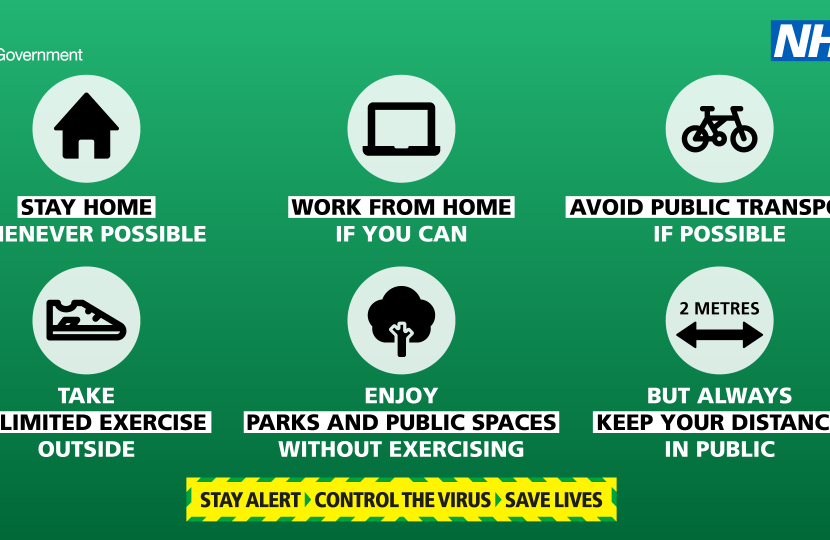
Business Secretary Alok Sharma speaking at the daily coronavirus press conference:
Good afternoon. I am joined today by Professor Stephen Powis, National Medical Director of NHS England and Sarah Albon who is the Chief Executive of the Health and Safety Executive.
First, I want to update you on the latest data on the coronavirus response.
2,007,146 tests for coronavirus have now been carried out in the UK, including 85,293 tests carried out yesterday.
226,463 people have tested positive, that’s an increase of 3,403 cases since yesterday.
11,605 people are currently in hospital with coronavirus, up from 11,465 the previous day
And sadly, of those tested positive for coronavirus, across all settings, 32,692 have now died. That’s an increase of 627 fatalities since yesterday.
This is of course devastating news for families across the UK, and we all need to stay alert and control the virus.
I just want to remind people of the details of the next phase of our fight against coronavirus that we set out this week.
If we turn to the first slide, in order to monitor our progress, we are establishing a new COVID Alert Level System, with five levels, each relating to the level of threat posed by the virus.
The alert level will be based primarily on the R value and the number of coronavirus cases.
And in turn that alert level will determine the level of social distancing measures in place.
The lower the level the fewer the measures; the higher the level the stricter the measures.
The social distancing measures remain critical in our efforts to control the virus.
Throughout the period of lockdown, which started on March 23 we have been at Level 4.
Meaning, a COVID-19 epidemic is in general circulation, and transmission is high or rising exponentially.
But thanks to the hard work and sacrifices of the British people in this lockdown, you have helped to bring the R level down and we are now in a position to begin moving to Level 3, in careful steps.
As you see on the next slide, we have set out the first of three steps we will take to carefully modify the measures, gradually ease the lockdown, and begin to allow people to return to their way of life - but crucially, while avoiding what would be a disastrous second peak that overwhelms the NHS.
After each step we will closely monitor the impact of that step on the R and the number of infections, and all the available data, and we will only take the next step when we are satisfied that it is safe to do so.
Step 1. From this week:
Those who cannot work from home should now speak to their employer about going back to work.
You can now spend time outdoors and exercise as often as you like.
You can meet one person outside of your household outside provided you stay 2 metres apart.
Step 2. From June 1, at the earliest, as long as the data allows, we aim to allow:
Primary schools to reopen for some pupils, in smaller class sizes.
Non-essential retail to start to reopen, when and where it is safe to do so,
Cultural and sporting events to take place behind closed doors, without crowds.
And then Step 3. No earlier than July 4, and again, only if the data says it is safe, we aim to allow:
More businesses and premises to open, including potentially those offering personal care such as leisure facilities, public places, and places of worship.
Many of these businesses will need to operate in new ways to ensure they are safe, and we will work with these sectors on how to do this.
As you will see from slide 3, having taken the first step in carefully adjusting some of the measures, and our advice to people on what to do, we have also updated our messaging.
We are now asking people to Stay Alert, Control the Virus and Save Lives.
Yes - staying alert, for the vast majority of people, still means staying at home as much as possible.
But there are a range of other actions we’re advising people to take.
People should stay alert, by:
Working from home if you can.
Limiting contact with other people.
Keeping distance if you go out - 2 metres apart where possible.
Washing your hands regularly.
Wearing a face covering when you are in enclosed space where it’s difficult to be socially distant - for example in some shops and on public transport.
And if you or anyone in your household has symptoms, you all need to self-isolate.
As slide 4 shows, if everyone stays alert and follows the rules, we can control coronavirus by keeping the R down and reducing the number of infections.
This is how we can continue to save lives, and livelihoods, as we begin as a nation to recover from coronavirus.
And to underpin this in the workplace, we have published new ‘COVID-19 secure’ guidance on working safely, available to UK employers, across 8 work settings, which are allowed to be open and where their employees cannot work from home.
This also includes guidance for shops which we believe may be in a position to begin a phased reopening at the earliest from the 1 June.
Firms, unions, industry bodies and the devolved administrations have all fed into this guidance to give businesses and their employees the confidence they need to work safely.
And I believe we have reached a consensus in doing that.
We have also worked with Public Health England and the Health and Safety Executive, to develop best practice on the safest ways of working across the economy.
The guidelines outline practical steps for employers to take, including carrying out a COVID-19 risk assessment, in consultation with employees or trades unions.
A downloadable notice is included in the documents, which employers should display in their workplace to show their employees, customers and other visitors, that they have followed this guidance.
We have also provided practical steps for employers to consider such as putting up barriers or screens in shared spaces, creating “fixed teams” or “partnering” to minimise the number of people in contact with one another, and frequent cleaning of work areas and equipment between uses to reduce transmission.
To support employers and employees through this, the government has made available up to an extra £14 million for the Health and Safety Executive, equivalent to an increase of 10% of their budget.
This is for extra call centre employees, inspectors and equipment, if needed.
We know how important the Job Retention Scheme has been in helping businesses through this difficult time.
And today the Chancellor has announced a four-month extension of the scheme to help provide certainty to businesses.
To date, 7.5 million jobs have been furloughed, protecting livelihoods across the nation.
Until the end of July, there will be no changes to the scheme.
Then from August to October the scheme will continue, for all sectors and regions of the UK, but with greater flexibility to support the transition back to work.
Employers currently using the scheme will be able to bring employees back part time.
And, as the economy reopens, we will ask firms to start sharing, with government, the cost of paying people’s salaries.
To be clear, the same level of support of 80% of people’s current salary, up to £2,500 will continue to be met, but through a shared effort between employers and government.
We will be setting out more details on the changes before the end of the month.
Throughout this pandemic, I have been struck by the way people have looked out for one another.
These measures are produced in that spirit.
So to employers I say: use this support and guidance to know you are doing the right thing and work with your unions and workers to keep each other safe.
And to workers I say: we are looking out for you; we want you to feel confident that you are financially supported and returning to a safe workplace.
Because in this time like no other, we all need to work together safely, as we rebuild our economy.
